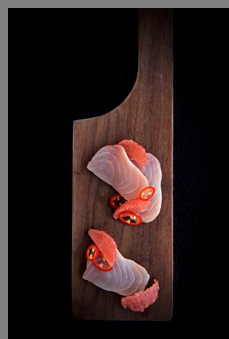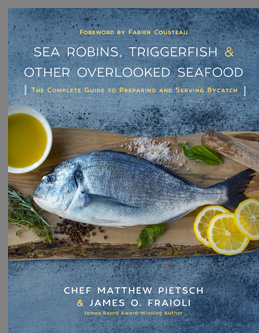As a certified scuba diver, I was "hooked" from the moment I saw the title of the book, Sea Robins, Triggerfish & Other Overlooked Seafood – The Complete Guide To Preparing And Serving Bycatch by Chef Matthew Pietsch and James O. Fraioli and saw that the foreward was by Fabien Cousteau, third-generation of the highly esteemed Cousteau family – who have contributed substantially to what the world knows about our oceans. Fabien Cousteau is the director of the Fabien Cousteau Ocean Learning Center, an ocean conservationist, and a documentary filmmaker.
To understand the terminology, the book distinguishes between "incidental catch" and "bycatch" described as, "Incidental catch: Those fish caught merely by chance or without intention or calculation and retained. Example: Hooking and keeping a grouper when fishing for snapper. Bycatch: The portion of a commercial fishing catch that consists of fish and other marine species caught unintentionally. These species may be incidental or discarded back to the sea. Example: Catching flounder and sea robins in a bottom trawl intended for cod and keeping the cod and flounder and discarding the sea robins."
With the overfishing of certain species, it is now time to look to the future and at alternative seafood, namely bycatch, by making it desirable for commercial fishermen to keep and sell, rather than let it waste or simply discard.
In addition to providing inspired recipes such as: Opah Crudo, Coconut Grilled Wahoo, Pan-Seared Monkfish With Beurre Blanc, Pickled Potatoes & Salt Cured Celery, Skate Wing With Lemon & Capers, Pan-Seared Lingcod With Smoked Mussels, Roasted Fennel Broth & Raw Fennel Salad, and Green Chile Lionfish, Triggerfish & Scallop Cioppino, to name but a few, the cookbook provides interesting notes about the fish used in each of the recipes, detailed step-by-step instructions, along with wine pairing suggestions.
Speaking at length with American Chef Matthew Pietsch, I learned about his culinary passion that has taken him from working as an Executive Pastry Chef, to Executive Chef, to restaurant owner and exotic bycatch cookbook author.

Chef Matthew Pietsch
photo by Jaimie Skriba
Interestingly, Chef Matthew Pietsch originally wanted to be an Electrical/Mechanical Engineer with a focus on Theatrical Sound Design, however in his second year of the program at Michigan Technological University, he decided to switch to a culinary program, and attended and graduated from the Grand Rapids Community College’s culinary arts program. This earned him a coveted spot on the prestigious US National Pastry Team in 2004. This lead to working as an Executive Pastry Chef in West Michigan, and a stint at Opus One working the savory side of the kitchen as a Sous Chef, before finding his way to Chef Michael Symon’s Detroit, Michigan restaurant, ROAST, where Chef Michael inspired his team by working alongside them on the line during the opening. Chef Matthew remembered how Chef Michael Symon used exceptionally high-quality products and treated them simply. He uses that approach in his own cooking style. He opened his own restaurant, Salt of the Earth in Fennville, Michigan in 2009, then opened his second restaurant, Principle Food & Drink in 2015 in Kalamazoo, Michigan. Passionate about all things culinary, even his Border Collie has a culinary name, Mise en Place, whom he nicknamed "Meezy."
He said that the essence of the cookbook is value driven towards sustainability of the species. At his restaurant, they are ingredient-focused, and they build relationships between the purveyors, local growers, and producers. Based in Michigan, seafood sourcing is a little difficult for them. The bycatch program allows them to support a small function of the commercial fishermen, although a small change can often make a great impact.
The cookbook is about awareness, making people aware of the impact on our oceans, asking about the source of our food, about its sustainability, and health. For consumers, he hopes that they will find value as a cooking resource that is both educational and fun, and visually impactful.
Chef Matthew Pietsch and James O. Fraioli graciously shares a delectable recipe for Opah Crudo from the cookbook, Sea Robins, Triggerfish & Other Overlooked Seafood – The Complete Guide To Preparing And Serving Bycatch.
Copyright ©2017 by Matthew Pietsch and James Fraioli. Foreward Copyright © by Fabien Cousteau.
Recipes copyright ©2017 by Chef Matthew Pietsch. Photographs copyright © 2017 by Matthew Pietsch.
Reprinted with permission from Skyhorse Publishing, Inc., Chef Matthew Pietsch & James O. Fraioli.

Opah Crudo
photo by Sandi Gunrett
Opah Crudo
Serves 8 -12
Alternative Fish: Haddock, Mahi-Mahi, Tuna
This submission from Roast colleague Bradley Ball utilizes the prize cut of the opah for an incredibly simple and unique experience that makes perfect use of your available time when sunshine is in abundance. Honestly, this dish screams summertime. The goal of this recipe is to create something fresh and quick. No one wins if you miss out on a perfect day outdoors to slave away in the kitchen the entire time. If you’re unfamiliar with how to slice the opah sashimi style, go online or seek out a local resource to help you. You can also have your fishmonger slice it for you.
Opah
Opah, or moonfish is one of the most colorful of the commercial fish species available in California and Hawaii. A silver-gray upper body color shades to a rose red dotted with spots toward the belly. Its fins are crimson, and its large eyes are encircled with gold. The moonfish’s unique round yet narrow profile may be the origin of its name.
The opah was viewed as a good luck fish by old-time fishermen, who would give it away as a gesture of goodwill rather than sell it. Only recently has this species become commercially important. Opah are not found in schools, and they are not caught in any quantity. They are a wandering pelagic species, often found in the company of tunas and billfish. Individual fish are regularly hooked incidentally by long-line boats fishing over seamounts. Landings follow no set pattern in any area, but the presence of opah at the depths of long-line fishing gear may be related to vertical migrations from the deep in search of food. Virtually all opah landed by long-liners is sold fresh through the Honolulu fish auction. Opah landed in Hawaii range from 60 to 200 pounds. The entire opah catch is marketed as whole, fresh fish. Most are filleted for restaurant use, both in Hawaii and for export to the US mainland.
Rising demand for fresh fish, particularly in the restaurants trade, has increased the interest in previously underutilized species like the opah. This species has now found a place on restaurant as a "catch of the day" particularly when more popular species are unavailable. An opah has four-types of large grain flesh, each has a different color. Behind the head and along the backbone (the top loin) is an orange flesh. Toward the belly, the flesh pales to a pink color and is somewhat stringy. The fish’s cheeks yield dark red flesh. Inside the fish’s breastplate is a smaller section of flesh. A bright ruby red or liver color, this flesh cooks to a brown color and is somewhat stringy and difficult to fillet.
Pickled Fresno Chilies
|
1 |
Cup |
Apple Cider Vinegar |
|
1 |
Cup |
Distilled White Wine Vinegar |
|
2 |
Cups |
Water |
|
4 |
Teaspoons |
Salt |
|
8 |
|
Garlic Cloves, smashed and peeled |
|
8 |
|
Allspice Berries |
|
16 |
Fresh |
Laurel Leaves, or 4 dried Bay Leaves |
|
1 |
Pound |
Fresno Chilies |
Opah Crudo
|
1 |
Pound |
Opah Top Loin, sliced sashimi style |
|
1 |
|
Grapefruit, peeled and cut into segments, see below |
|
2 |
Whole |
Pickled Fresno Chilies, shaved paper-thin |
|
|
|
Flake Salt, as needed |
|
|
|
Italian Extra-Virgin Olive Oil, as needed |
|
|
|
Cilantro Leaves, to garnish |
To Make The Pickled Fresno Chilies
In a non-reactive pot over medium-high heat, add both vinegars, water, salt, garlic, allspice, and laurel leaves. Bring to a boil. Remove from heat and allow to cool for 15 minutes. Pack the chilies into a sterilized container and cover well with the brine. Seal and allow to sit for at least 1 week.
How To Segment A Grapefruit
Place the grapefruit on a cutting board, and using a very sharp utility knife, slice the ends from the fruit at the stem and perfectly parallel to the first cut. The goal is to imagine a perfect vertical line from the center of the fruit upon removing each end. Once firmly placed on your cutting board, carve the skin of the fruit, making arcs with your knife cuts, starting at the top of the fruit and meeting at the bottom of the grapefruit. The cut should reveal the interior flesh of the grapefruit. Move your knife to remove the next portion of the peel, using the arc presented by the previous cut as a guide. "Peel" the remaining skin of the fruit and trim up any spots of pith that remain.
Hold the fruit firmly using a towel (to provide a better grip, and to protect your hand) and use a small, sharp knife to cut on one side of the skin that defines a segment of fruit. Make an additional cut on the opposite side of the first cut to release the segment of fruit. The remaining portion of fruit should be free of any skin. Reserve the segments in a small dish, and squeeze any remaining juice from the "skeleton" of grapefruit to cover.
To Make The Orpah Crude
Arrange the slices of opal onto a serving platter. Garnish the slices of fish with the grapefruit segments and shaved slices of the Pickled Fresno Chilies. Top the fish with flake salt. Finish with a light drizzle of olive oil and a small spoonful of remaining grapefruit juice. Garnish with the cilantro leaves.
Note: There is no substitute for a high-end finishing olive oil. Do a little research before making a purchase, as there are many imposters to wade through. Keep a bottle hidden and use for simple finishing touches such as this. Look for a DOP label on whatever you purchase, signifying the authenticity of the olive oil.
Suggested Pairing
Gewürztraminer, Pfalz, Germany
When fully developed, this wine provides an unparalleled sipping experience. Textbook flavors of lychee, pepper spice, and sweet fruit harmoniously dance with mouth-filling acidity. Odd to this part of Germany, Gewürztraminer finds its balance in the dry and sunny areas sitting atop high elevation vineyards. Look for a style that provides enough acid to balance the sweetness and cut through any spiciness this dish might provide.
Sea Robins, Triggerfish & Other Overlooked Seafood – The Complete Guide To Preparing And Serving Bycatch by Chef Mathew Pietsch and James O. Friuli with Foreword by Fabien Cousteau is published by Skyhorse Publishing, Inc. and is available as a hardcover and as an eBook. ISBN: 9781510717503. $35.00
The book is available in bookstores and online, including: Amazon, Barnes & Noble, and Walmart.
Skyhorse Publishing, Inc.
307 West 36th Street, 11th Floor
New York, New York 10018
United States
Telephone: +1-212-643-6816
Website: www.SkyhorsePublishing.com
Follow Luxury Experience on Facebook at www.Facebook.com/LuxuryExperience to see photos and videos.
Follow Luxury Experience on Twitter at www.twitter/LuxuryPair
© September 2017. Luxury Experience. www.LuxuryExperience.com. All rights reserved.



